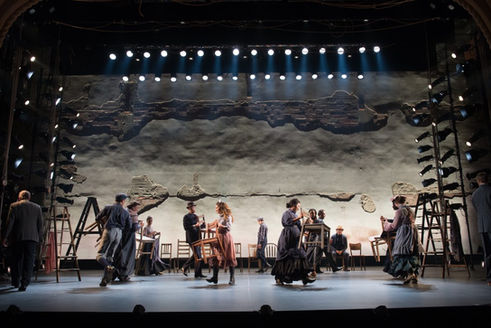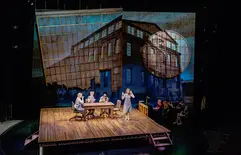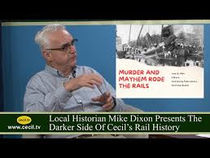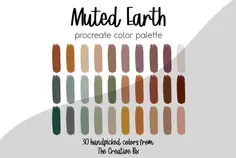

EXAMPLE VISION STATEMENT:
THE FOLLOWING IS AN EXAMPLE OF A VISION STATEMENT FOR A PRODUCTION OF THORNTON WILDER'S OUR TOWN. PLEASE NOTE THAT YOUR VISION STATEMENT DOES NOT NEED TO BE THIS IN DEPTH, BUT IT SHOULD INVOLVE ALL ELEVEN SECTIONS OF THE STATEMENT. PLEASE KEEP YOUR VISION STATEMENT AROUND 1,000 WORDS AND SUBMIT IT TO AMITCHELL@CECIL.EDU ALONG WITH A VISUAL GUIDE TO YOUR VISION STATEMENT.
Director’s Vision Statement – Our Town at the Milburn Stone Theatre
Introduction
Thornton Wilder’s Our Town is a meditation on the beauty of everyday life, emphasizing the small, often unnoticed moments that make up our existence. If I am granted the opportunity to direct this show at the Milburn Stone Theatre, I plan on embracing a minimalist, immersive, and deeply personal approach, stripping away theatrical artifice to reveal the raw human connections at the play’s core. By utilizing simplified costume designs, a vibrant lighting approach, an untraditional set design, and some audience participation, I plan on inviting patrons to step into Grover’s Corners—not as passive observers, but as active participants in its story.
The goal for this production is simple: Our Town is Your Town. The production will serve not only as a retelling of a classic work but as a reflection of Cecil County, Maryland, and the various communities that make up our region. Our Town speaks to the universality of human experience, and this production will embrace those themes while also rooting the play in a tangible, local reality, making it resonate with the people of Cecil County, the extended region of the counties that surround Cecil County and the Cecil College community.
Concept & Interpretation
This production of Our Town will lean towards theatrical minimalism that is essential to the play's traditional presentation to highlight the universal themes found in the text. Instead of a conventional small-town setting that you could create for Our Town, I hope we create an abstract, impressionistic space that represents the emotional landscape of Grover’s Corners rather than a literal depiction of rooms and space. This approach will allow the play’s themes to transcend time and location, making direct connections between the fictional town and the contemporary.
-
No traditional scenery – The world of the play will be shaped by light, movement, and sound, rather than elaborate set pieces other than that of tables, chairs, ladders, benches, a few select items along with exposed lighting instruments that I would like to be visible - breaking the ideals of realism.
-
Moments of heightened realism – While most of the play’s staging will be simple, key emotional moments (such as Emily’s return to the past) will feature striking visuals and auditory shifts to contrast memory with reality with choreography and movement from the ensemble.
-
Breaking the fourth wall – The Stage Manager’s direct engagement with the audience will be emphasized, making them an active participant rather than a distant narrator. The Stage Manager will go directly to the audience, sitting with them in the house and evening watching part of the show with them.
The goal is to make Grover’s Corners feel like any small town, including those nearby in Cecil County. The production will explore connections between the past and present, reinforcing the idea that the cycles of life are the same no matter the era.
Lighting & Design
-
Vibrant Lighting as Storytelling – I would like to have the lighting shift dynamically to reflect time, emotion, and perspective. Soft, naturalistic tones will contrast with bold, surreal hues in moments of memory, reflection and realization. The hope will be that this will help the audience understand and appreciate the changes that happen in the show,
-
Projection Mapping – I would like to have key pieces of text, archival photos of small-town life - possibly even archival photos of Cecil County, and possibly audience-contributed reflections will be projected onto the stage space at key moments, tying the play’s themes to real-world experiences. Bring the community into the theatre and make it a shared experience.
-
Fluid, Transformative Space – The environment will be shaped by actors moving props, benches, and tables around in a seamless transition, reinforcing the play’s themes of impermanence and fludity. These moments will be choreographed, ideally to music, and seen almost as the cast dances through time.
Costumes
-
Classic costuming that turns into simple, timeless attire – The ideal look would be to start in 1901 and gradually shift into a neutral, era-ambiguous clothing will allow the characters to exist beyond 1901, reinforcing the play’s universal themes.
-
Subtle Color Story – While most characters will wear muted, earthy tones, Emily’s costume will shift to a bright, ghostly white in Act III, symbolizing her transition to memory.
Blocking & Movement
-
Choreographed Simplicity – Every movement will be purposeful, reflecting the rhythm of small-town life while also guiding the audience’s focus.
-
Dynamic Stillness – Key moments of stillness (such as Emily’s final realization) will be carefully staged to draw the audience into the emotion of the moment.
Sound & Music
-
Live Soundscapes – I would like to explore the idea of incorporating speakers in various places in the house that will emit subtle, live-created sounds (think: rustling leaves, distant birds, soft footsteps) in the hopes that it will reinforce the sensory world of Grover’s Corners.
-
Minimalist Underscoring – I would like to bring in 2-3 musicians to play acoustic folk music throughout the show as underscoring. This will help keep the plot moving and engage the audience throughout the performance.
Audience Immersion & Interaction
-
Pre-Show: The Grover’s Corners Census – Audience members will answer personal reflection prompts that will be projected during Act III.
-
Act II Wedding Procession – Select audience members will be invited to stand as wedding guests, blending performance and reality.
-
Post-Show Community Reflections – Attendees will be encouraged to share their own reflections on cherishing the small moments through written or recorded messages.
Casting Approach
-
Authenticity & Diversity – I would like to find a cast that reflects the community of Cecil County, emphasizing relatable, grounded performances rather than just "actors." I plan on trying to find "non-traditional" actors for this production by reaching out to the public libraries and try to find people who might not see themselves as performers, but would be vibrant and alive in Grover's Corner.
-
Doubling of Roles – You could have over 28 performers in a production of Our Town. I plan on doubling (and in some points tripling) the roles in the show. Some actors will be asked to play multiple characters to reinforce Our Town’s themes of interconnectedness and to also keep the cast size manageable.
Rehearsal Process & Directing Style
-
Collaborative Exploration – As part of a "warm-up exercise" before we begin rehearsals - actors will be encouraged to bring personal stories to share with other that share connections to the play, hopefully deepening their connection to the text's themes and their fellow performers.
-
Physical Improvisation – I plan on spending 2-3 rehearsals based only on movement exercises - walking with chairs, benches, finding ways to move then in the space with each other, treating the movement of these items as choreography - this will help develop organic, naturalistic performances.
Community Engagement & Educational Partnerships
A few possible ideals to create community engagement could include:
-
Cecil County Public Schools
-
Work with CCPS to create student projects reflecting their own “small moments.” These moments could also be shared in the lobby or as a digital display.
-
-
Cecil County Public Libraries
-
Work with local Historian Mike Dixon on a potential oral history project collecting stories from Cecil County residents and compare them to historical data.
-
In addition to the oral history project - work with CCPL on a community book club date to discuss how Our Town relates to local history.
-
-
Local Businesses & Sponsorships
-
Work with local business and coffee shops to create a special menu item and/or window displays connecting to Our Town’s themes.
-
Final Thoughts
If I am selected to direct this production of Our Town the goal will be to make this show more than just a performance—it will be to create an immersive, community-centered experience that connects Thornton Wilder’s masterpiece to the stories, voices, and traditions of Cecil County. By embracing aspects of theatrical minimalism, encouraging audience interaction, and working with the community to encourage local engagement, the goal will be to create a production that is both timeless and deeply rooted in the present moment.
this staging of Our Town will be a love letter to the beauty of everyday life, encouraging audiences to reflect on their own communities, relationships, and memories. Just as Our Town urges the characters in the story to appreciate the small moments before they pass, the hope of this production will also serve as an invitation for the people of our community to cherish the beauty of their own lives.
---
Below you will find images that help support my vision and ideas for the production including costume ideas, set concepts, projection mapping, lighting designs to consider, color palette for costume colors, and more:















Hi, This Is Hidden Text.
